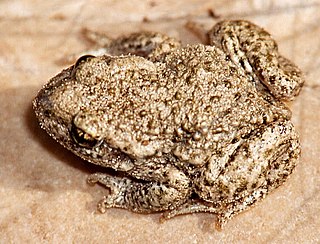
The Alytidae are a family of primitive frogs. Their common name is painted frogs or midwife toads. Most are endemic to Europe, but three species occur in northwest Africa, and a species formerly thought to be extinct is found in Israel.

Sooglossidae, the Seychelles frogs or Seychelles Island frogs, are a family of frogs found on the Seychelles Islands. Until recently, this family was believed to include the genera Sechellophryne, Nesomantis and Sooglossus, but following a major revision of amphibians in 2006, the genus Nesomantis was named a junior synonym of Sooglossus. Their closest relatives are the purple frogs (Nasikabatrachidae) of India.

Phyllodytes is a genus of frogs in the family Hylidae. It is endemic to eastern Brazil.
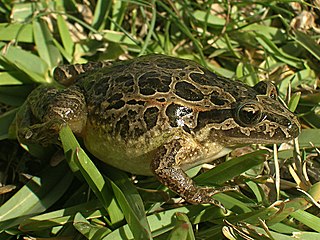
Discoglossus is a genus of frogs in the family Alytidae found in southern Europe and northwestern Africa.
Mount Duida frogs (Dischidodactylus) form a genus of brachycephaloid frogs endemic to the tepuis of southern Venezuela. The scientific name is derived from the Greek dischidos, meaning divided, and dactylos, meaning finger or toe, in reference to the divided ungual flap.
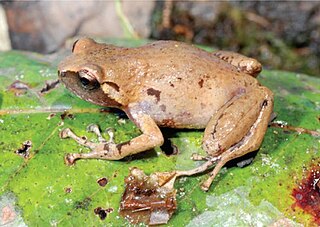
Oreophryne, the cross frogs, is a genus of microhylid frogs. They are found in the southern Philippines, Sulawesi and the Lesser Sunda Islands, and New Guinea and New Britain.
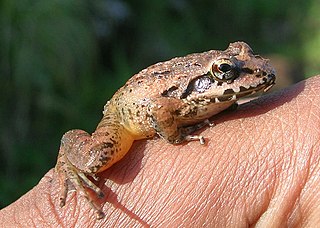
Indirana is a genus of frogs in the family Ranixalidae. These frogs are endemic to the Western Ghats of India. They are sometimes known under the common name Indian frogs, whereas members of their parent family are named "leaping frogs".

Cryptobatrachus is a genus of frogs in the family Hemiphractidae. They are found in Colombia and Venezuela. They are also known as backpack frogs, as the females have the habit of carrying their egg clutch on their backs until the young hatch; this behavior also occurs in the related hemiphractid genera Hemiphractus and Stefania.
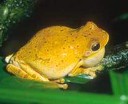
Tlalocohyla is a genus of frogs in the family Hylidae, also known as rain treefrogs or Middle American yellow-bellied treefrogs. They occur in Middle America between Mexico and Costa Rica. This genus was created in 2005 following a major revision of the Hylidae. The five species in this genus were previously placed in the genus Hyla.

Dendropsophus is a genus of frogs in the family Hylidae. They are distributed in Central and South America, from southern Mexico to northern Argentina and Uruguay. They are sometimes known under the common name Fitzinger neotropical treefrogs or yellow treefrogs
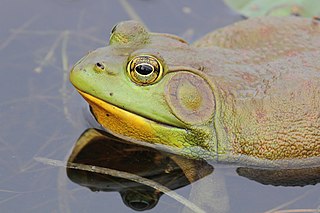
Lithobates, commonly known as the bullfrogs, is a genus of true frogs, of the family Ranidae. The name is derived from litho- (stone) and the Greek bates, meaning one that treads on rock, or rock climber. As presently defined, it includes many of eastern North America's most familiar aquatic frog species, including the American bullfrog, green frog, and the leopard frogs.

Discoglossus scovazzi, the Moroccan painted frog, in French discoglosse peint or discoglosse à ventre blanc, is a species of frog in the family Alytidae. It is found in Morocco and the Spanish North African enclaves Ceuta and Melilla.

Limnomedusa macroglossa is a species of frog in the family Alsodidae, in the monotypic genus Limnomedusa. It is found in southern Brazil, northeastern Argentina, Uruguay, and northern Paraguay.

Macrogenioglottus is a genus of frogs in the family Odontophrynidae. It is monotypic, being represented by the single species, the Bahia forest frog. It is endemic to the Atlantic Forest of southeastern Brazil. Its natural habitats are primary and old secondary forests, but it can also live in agroforestry systems such as cacao plantations. Habitat loss is a potential threat to this species.
Arcovomer is a genus of frogs in the family Microhylidae. It is monotypic, being represented by the single species Arcovomer passarellii, commonly known as Passarelli's frog. It is endemic to south-eastern Brazil and found in Espírito Santo, Rio de Janeiro, and São Paulo states. Frogs from Espírito Santo may represent another, undescribed species. The name honours Antonio Passarelli who collected the holotype.

Ericabatrachus is a genus of frogs in the family Ericabatrachidae endemic to the Bale Mountains in Ethiopia. It is monotypic, being represented by the single species Ericabatrachus baleensis, commonly known as the Bale Mountains frog. It was previously included in the family Petropedetidae, but has gotten its own monotypic family, Ericabatrachidae.
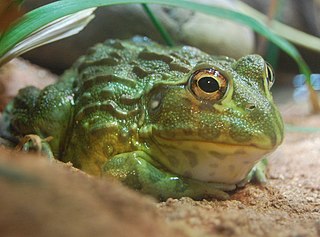
The Pyxicephalidae are a family of frogs currently found in sub-Saharan Africa. However, in the Eocene, the taxon Thaumastosaurus lived in Europe.

Craugastoridae, commonly known as fleshbelly frogs, is a family of New World direct-developing frogs. As delineated here, following the Amphibian Species of the World, it contains 129 species. They are found from the southern United States southwards to Central and South America.

Ceuthomantis is a small genus of craugastorid frogs, also treated as comprising their own monogeneric family Ceuthomantidae. They are found in the southern and eastern parts of the Guiana Highlands in Venezuela, Guyana, and Brazil. The generic name is derived from the Greek noun mantis, which means treefrog, and adjective keuthos, which means hidden, in allusion to the hidden existence of this genus in the tepuis of the Guiana Shield.
Saïda Hossini is a Moroccan palaeontologist, specialising in frogs of the Pleistocene.


















